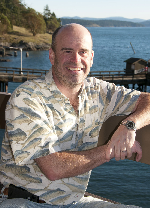 Dr. Adam Summers is trained as an engineer and mathematician, he turned to biology to satisfy a deep need to interact with nature. His research applies simple physics and engineering principles to animals to understand the evolution of complex behaviors like feeding, movement and reproduction. The images shown here are the raw material that underlies his research. He is a professor at the University of Washington’s Friday Harbor Labs, author of more than 90 papers, and was the scientific consultant on Finding Nemo. He is obsessed with fishes and has recently come to realize that the tools and aims of science, art and poetry are more congruent than he had supposed. All the cleared and stained fishes can be seen at http://www.picturingscience.com (Editor’s note: Adam was also featured in Gizmodo this week)
Dr. Adam Summers is trained as an engineer and mathematician, he turned to biology to satisfy a deep need to interact with nature. His research applies simple physics and engineering principles to animals to understand the evolution of complex behaviors like feeding, movement and reproduction. The images shown here are the raw material that underlies his research. He is a professor at the University of Washington’s Friday Harbor Labs, author of more than 90 papers, and was the scientific consultant on Finding Nemo. He is obsessed with fishes and has recently come to realize that the tools and aims of science, art and poetry are more congruent than he had supposed. All the cleared and stained fishes can be seen at http://www.picturingscience.com (Editor’s note: Adam was also featured in Gizmodo this week)
In my work I apply simple Newtonian physics and a bit of engineering to problems of how animals do those amazing things. The source of questions is the natural world and there is no better skill set in my business than that of the natural historian. A keen eye for what is going on around you, and a willingness to document it, is a powerful engine for generating great questions. Proposing answers to those questions almost always involves understanding the shape of the underlying system. So, the second most important set of tools I have are anatomical. Key insights are found in a deep understanding of the skeletal system and its associated soft tissue. A common tool in my lab is clearing and staining, which results in an entire specimen that has its mineralized tissue stained red and cartilage a deep blue.
Read More “On the clarity of animals: the art and science of clearing and staining” »